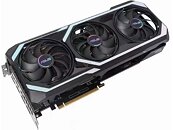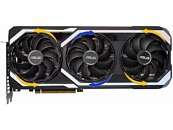Mar 26th, 2025 17:46 EDT
change timezone
Latest GPU Drivers
New Forum Posts
- Did Nvidia purposely gimp the performance of 50xx series cards with drivers (72)
- Windows 10 Vs 11, Which one too choose? (105)
- Can you guess Which game it is? (2)
- Would you buy this keyboard? (2)
- What features do you want to see in a first person survival horror game? (48)
- Biostar RX 6700 XT OC BIOS (12)
- Anime Nation (13020)
- asRock rx 580 8gb 2048sp 6pin I can't find bios (2)
- RX 560 Randomly crashing and blackscreen (59)
- Is RX 9070 VRAM temperature regular value or hotspot? (235)
Popular Reviews
- Assassin's Creed Shadows Performance Benchmark Review - 30 GPUs Compared
- be quiet! Pure Rock Pro 3 Black Review
- ASUS ProArt X870E-Creator Wi-Fi Review
- ASRock Radeon RX 9070 XT Taichi OC Review - Excellent Cooling
- Pulsar Feinmann F01 Review
- Sapphire Radeon RX 9070 XT Nitro+ Review - Beating NVIDIA
- ASRock Phantom Gaming B860I Lightning Wi-Fi Review
- Samsung 9100 Pro 2 TB Review - The Best Gen 5 SSD
- ASUS GeForce RTX 5070 TUF OC Review
- AMD Ryzen 9 9950X3D Review - Great for Gaming and Productivity
Controversial News Posts
- AMD RDNA 4 and Radeon RX 9070 Series Unveiled: $549 & $599 (260)
- MSI Doesn't Plan Radeon RX 9000 Series GPUs, Skips AMD RDNA 4 Generation Entirely (142)
- Microsoft Introduces Copilot for Gaming (123)
- AMD Radeon RX 9070 XT Reportedly Outperforms RTX 5080 Through Undervolting (118)
- NVIDIA Reportedly Prepares GeForce RTX 5060 and RTX 5060 Ti Unveil Tomorrow (115)
- Over 200,000 Sold Radeon RX 9070 and RX 9070 XT GPUs? AMD Says No Number was Given (100)
- NVIDIA GeForce RTX 5050, RTX 5060, and RTX 5060 Ti Specifications Leak (96)
- Retailers Anticipate Increased Radeon RX 9070 Series Prices, After Initial Shipments of "MSRP" Models (90)
Wednesday, January 27th 2021

ASUS GeForce RTX 3070 and RTX 3060 Ti Megalodon Graphics Cards Pictured
ASUS is readying the new Megalodon line of graphics cards. Aesthetically, these cards bear some resemblance to the ROG Strix, but are likely slotted below even the TUF Gaming series, with metal cooler shrouds and back-plates making way for what appear to be plastic ones. The coolers still keep the Axial-Tech fans, which ventilate a lighter heatsink than the one found in the ROG Strix cards. The PCB appears to be similar to the company's DUAL series cards, with single 8-pin PCIe power inputs for the RTX 3060 Ti, and possibly additional connectors for the RTX 3070. It's very likely that ASUS is selling the Megalodon series only in the Chinese market.
Source:
VideoCardz
Mar 26th, 2025 17:46 EDT
change timezone
Latest GPU Drivers
New Forum Posts
- Did Nvidia purposely gimp the performance of 50xx series cards with drivers (72)
- Windows 10 Vs 11, Which one too choose? (105)
- Can you guess Which game it is? (2)
- Would you buy this keyboard? (2)
- What features do you want to see in a first person survival horror game? (48)
- Biostar RX 6700 XT OC BIOS (12)
- Anime Nation (13020)
- asRock rx 580 8gb 2048sp 6pin I can't find bios (2)
- RX 560 Randomly crashing and blackscreen (59)
- Is RX 9070 VRAM temperature regular value or hotspot? (235)
Popular Reviews
- Assassin's Creed Shadows Performance Benchmark Review - 30 GPUs Compared
- be quiet! Pure Rock Pro 3 Black Review
- ASUS ProArt X870E-Creator Wi-Fi Review
- ASRock Radeon RX 9070 XT Taichi OC Review - Excellent Cooling
- Pulsar Feinmann F01 Review
- Sapphire Radeon RX 9070 XT Nitro+ Review - Beating NVIDIA
- ASRock Phantom Gaming B860I Lightning Wi-Fi Review
- Samsung 9100 Pro 2 TB Review - The Best Gen 5 SSD
- ASUS GeForce RTX 5070 TUF OC Review
- AMD Ryzen 9 9950X3D Review - Great for Gaming and Productivity
Controversial News Posts
- AMD RDNA 4 and Radeon RX 9070 Series Unveiled: $549 & $599 (260)
- MSI Doesn't Plan Radeon RX 9000 Series GPUs, Skips AMD RDNA 4 Generation Entirely (142)
- Microsoft Introduces Copilot for Gaming (123)
- AMD Radeon RX 9070 XT Reportedly Outperforms RTX 5080 Through Undervolting (118)
- NVIDIA Reportedly Prepares GeForce RTX 5060 and RTX 5060 Ti Unveil Tomorrow (115)
- Over 200,000 Sold Radeon RX 9070 and RX 9070 XT GPUs? AMD Says No Number was Given (100)
- NVIDIA GeForce RTX 5050, RTX 5060, and RTX 5060 Ti Specifications Leak (96)
- Retailers Anticipate Increased Radeon RX 9070 Series Prices, After Initial Shipments of "MSRP" Models (90)




28 Comments on ASUS GeForce RTX 3070 and RTX 3060 Ti Megalodon Graphics Cards Pictured
trog
Super duper cool! /s (again)....
wiki.guildwars2.com/wiki/Champion_Risen_Megalodon
The middle fan spins in a different direction but still same thing applies to it. It grabs the air and push it towards the heat-sink.
No, it's not hard to grasp for me since I don't have a problem with the design but you do, You don't understand how the fan works but maybe you just can't clearly explain what your problem is? Are the arrows in the picture the problem for you? The arrows show the air flow. Which is opposite to the spin of the fans. Arrows show the direction of the air being pushed by the blades.
I only mentioned blade geometry because that's how we can tell from the images which way the fans are designed to rotate. I wasn't talking about how the fans nor the cooler works. I was talking about the marketing images having arrows clearly meant to illustrate the direction of rotation of each fan (highlighting that the middle one rotates opposite of the two others, which is common for coolers like this after all), but managed to make all of these arrows point the wrong way! Which is silly and amateurish. It obviously has no relation to the function of the cooler, I just pointed out a silly mistake.
Think about the air flow and the arrows and how else would you have drawn them to show the airflow . Hopefully you will get your answers you seek and get to a conclusion. I'm done here :)